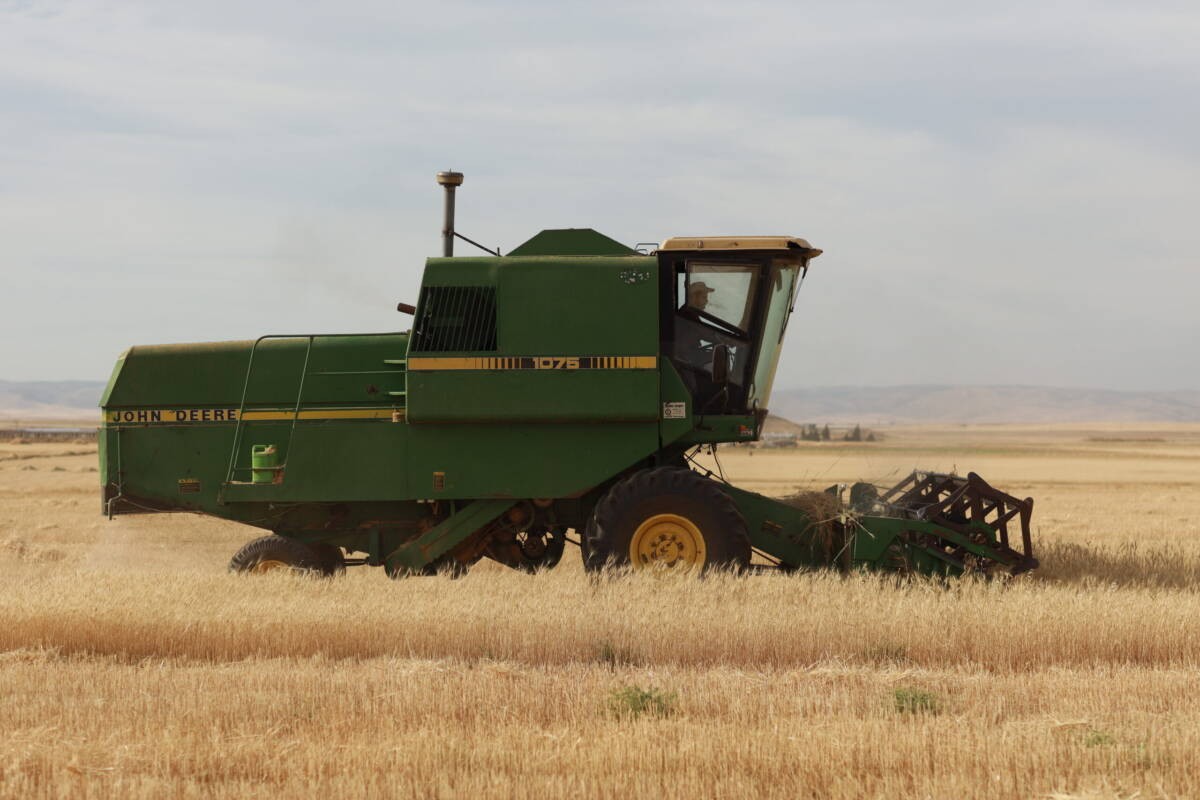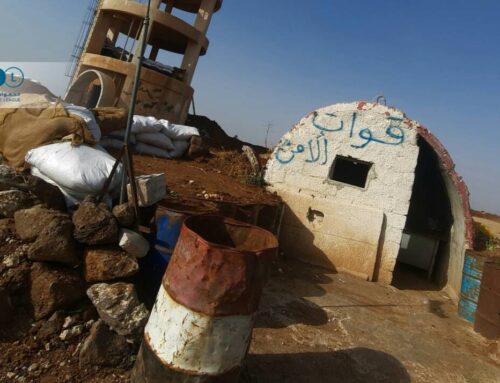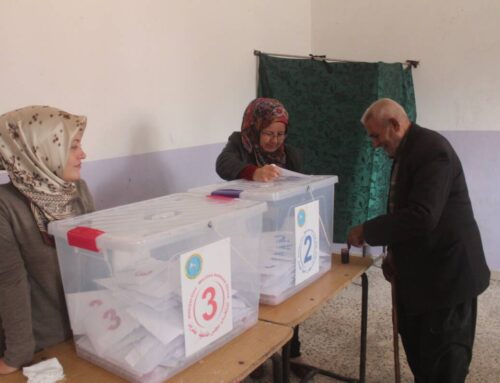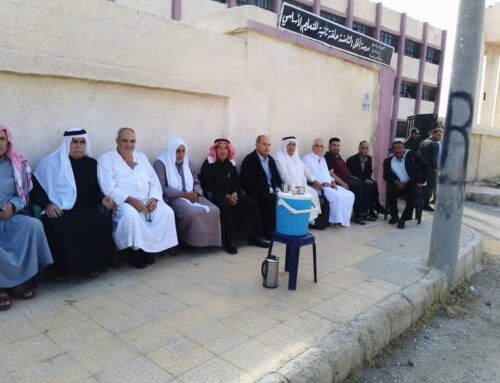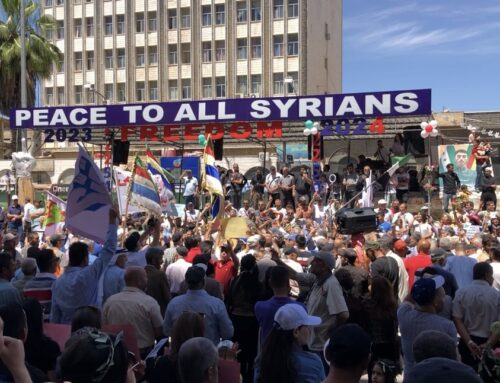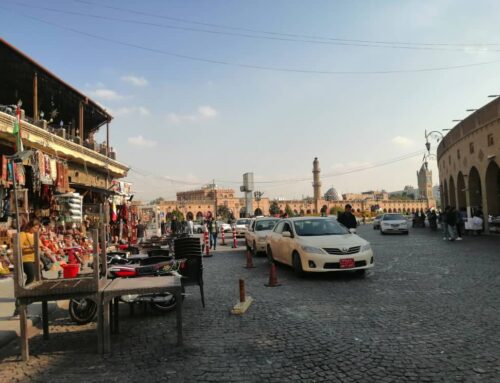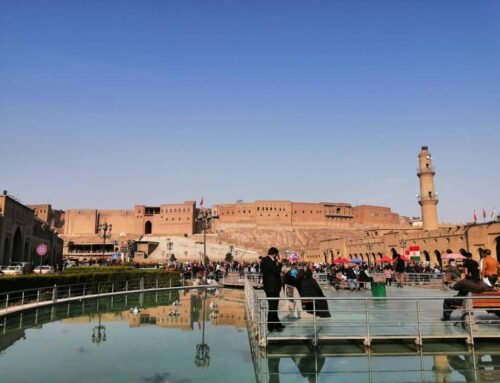Wheat price ‘disaster’ in northeastern Syria spells trouble for next season
A sharp decrease in the wheat price set by the AANES sparked protests and has left northeastern Syria’s farmers questioning the economic viability of cultivating their land next season.
6 June 2024
For several days last week, farmer Jamil Abdullah Hesso sat in the middle of the market street in Amouda, a city in Syria’s northeastern Hasakah province. Other farmers joined him, all sitting in to protest the price set by the Autonomous Administration of North and East Syria (AANES) to buy wheat from growers in its areas of influence: $0.31 per kilogram.
Hasso learned of the new price on May 26, while he was on his way to his land in Amouda. “I nearly caused a traffic accident,” the farmer told Syria Direct. “That price will cost me money and put me in debt for years.”
The AANES Agriculture and Irrigation Board’s decision to lower the price of wheat this year—it stood at $0.43 per kilogram in 2023—met with widespread opposition. Protests swept northeastern Syria, as farmers and their allies took to the streets holding signs reading “our livelihood is not your profitable trade” and “we watered it with our blood, we won’t sell it for free.”
Protesters demanded a higher wheat price than last year, citing high growing costs and little AANES support for the farming sector. Farmers are the backbone of the economy in Syria’s northeastern Jazira region, an area that includes land in Hasakah, Raqqa and Deir e-Zor provinces. It has long been considered Syria’s “food basket,” growing strategic crops such as wheat, barley and cotton.
Around this time every year, the rumbling din of combines fills Syria’s northeastern countryside as the machine’s operators drive from one wheat field to another. Piles of white bags filled with the life-sustaining grain line the ground, while tents providing shade and rest for laborers perch on the side of roads that run between plots of land. In harvest time, the noise of the countryside surpasses the bustle of nearby cities. But this year, “farmers have lost the pleasure of it, due to the decision,” Hesso said.
The momentum of protests against the new pricing lasted for days, but did not move the AANES to change its decision. In a press conference on May 28, the Agriculture and Irrigation Board refused to relent, while acknowledging the price “may not suit the cost and profit criteria.”
Ahmad Younes, the board’s deputy co-chair, said “the economic blockade and repeated attacks by Turkish aggression on the infrastructure and economy” led to “substantial economic losses, and the AANES’ inability to give the farmer brothers a large profit margin, in addition to the falling price of wheat globally.”
With little hope of a price adjustment, some farmers have started to bring their harvested wheat to receiving centers previously designated by the AANES.
A losing season
This past April, Younes told local media the AANES was in the process of determining this year’s wheat price, which he hinted would be a “pleasant surprise for farmers.” The reality was a “catastrophe,” as Hesso put it. He poured $28,000 into his crop this year, between plowing, cultivation, seeds, fertilizer, pesticides and manufacturing costs, not including labor and post-production harvesting, packaging and transportation.
For each of the 250 dunums Hesso planted in the Amouda countryside this year, he expects to harvest 250 kilograms of wheat, for a total production of 62.5 tons. At the set price, he would make $19,375, losing more than $8,000 without accounting for post-production costs.
Farmers in northeastern Syria have faced tough seasons before. Poor rainfall in previous years brought heavy losses, while fires in 2019 consumed more than 79,000 dunums of wheat and barley fields.
While lowering the wheat price this year, the AANES’ agriculture authority promised farmers—through statements by its deputy co-chair Younes—to provide bags to package wheat. It has not kept that promise, and farmers have bought their own bags.
Earlier in the season, farmers also had to pay for market-rate fuel to irrigate their land, after the AANES only provided small amounts of the subsidized fuel it promised them, multiple farmers told Syria Direct.
Read more: Fuel crisis and weak subsidies threaten Syria’s northeastern bread basket
Hesso received 6,750 liters of subsidized mazot (diesel) at a price of SYP 1,100 per liter this season. It covered a single watering of less than half of his land. He had to buy more than 11,000 liters of market-rate mazot for SYP 4,800 to fill the gap, paying up to $3,250 in all.
The AANES distributes subsidized mazot to farmers in batches, and this year allocated 10-15 liters of mazot for each dunum of land per batch. Hesso received one-and-a-half batches of the fuel he was supposed to receive. Some farmers have not received their allotments, or at best received between three and five batches.
Farzad Khalo, the sheikh of the Marsini clan in Syria’s Jazira region, sat with his brothers and relatives at his guesthouse (madafa) in Topiz, a village on the road between Qamishli and Amouda. He read numbers out of a small notebook in his hand, calling it “a ledger of losses, instead of profits.”
Khalo owns 80 dunums of land planted with wheat. According to the figures in his notebook, “the costs of planting and harvesting were $2,500, while the returns, in the best case, are $2,480,” he said. “That is if the agriculture board’s inspection doesn’t deem it defective, and agrees to buy it for $0.31,” he said.
The Agriculture and Irrigation Board said in its pricing decision this year that wheat would be subject to a numerical grading system. The price of $0.31 per kilogram only applies to the best quality grain.
Repercussions
During each harvest in northeastern Syria, farmers customarily calculate the economic viability of their land’s production in order to plan for the next round of planting. Going off of the figures written in Khalo’s “ledger of losses,” he will not be able to maintain the same level of production next season. He may decide not to cultivate his land at all.
“I would rather not farm my land than plant it and lose,” Khalo said, adding that he has considered “planting legumes next year and selling them to traders.” One of his guests interjected, advising him to “leave it barren—it will save you the loss.”
Nahla al-Ali, a civil activist who supports farmers’ demands in Deir e-Zor province, said growers she knows “won’t plant wheat next year, whether they are smallholders who will store their wheat and not sell it [this year], or large holders who will barely recover their capital.”
The wheat crisis caused by this season’s low price will not only impact farmers, but lead to “fewer jobs, which will impact the regional economy, as its residents do work related to the agricultural season,” economist Sirius Abdulmassih said. Abdulmassih has worked with farmers as an accountant since 1987, and also grows his own crops.
“More than 30 workers will lose jobs on my land next year,” Abdulmassih said. “I will not plant it due to the losses I’ve suffered.”
In the May 28 statement in which the AANES held firm to its wheat pricing, it estimated the cost of producing the grain to be $0.29 per kilogram. This is an “imprecise figure,” the economist said. He estimates it costs $0.30 to produce a kilogram of irrigated wheat, “not counting wages for the harvest, which reach seven percent of total sales, or the costs of packaging, shipping and transportation.” One kilogram of rain-fed wheat costs around half that, $0.16 before post-production costs.
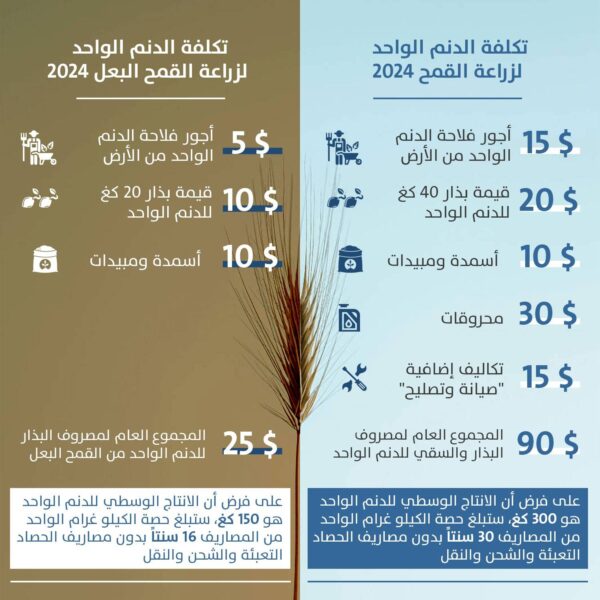
An infographic based on figures provided by economist Sirius Abdulmassih lays out the estimated cost of producing a kilogram of irrigated (right) and rain-fed (left) wheat. (Salim Abdulmassih/Bahaa Burhan)
Few options
Northeastern Syria’s strategic wheat, barley and cotton crops constitute a basic source of income for the region’s residents, from farmers to day laborers. However, they are increasingly threatened by rising annual farming costs and meager support from local authorities.
Many farmers in the Jazira region already reduce the areas of irrigated crops this season as a result. Some turned to rain-fed farming, while others planted aromatics such as cumin, coriander and sesame instead, Syria Direct reported in February.
For their wheat to fetch a better price, farmers could—in theory—take their crops to Syrian government grain centers instead of the AANES. Damascus set its price for wheat this season at SYP 5,500 ($0.36 at the current black market exchange rate, and $0.40 at the official rate).
“The AANES will prevent wheat being supplied to government centers,” as it did last year, Khalo said. He believes “it is the farmer’s right to sell the crop at the highest price.”
“Certainly, the [local] government stops us from selling the crop to the Syrian government, which leaves us helpless,” Hesso echoed.
In Deir e-Zor, activist al-Ali expects some farmers will smuggle their wheat across the Euphrates River to regime areas for a higher price, though this poses “a threat to their security and safety, and the security of the region.”
Hesso, in Hasakah, has already made up his mind to sell his crop locally, despite the impact the loss will have on him and his family. “Regardless of the AANES undervaluing us, I won’t sell the wheat outside the area,” he said. “I am fully aware of how important this strategic crop is.”
This report was produced as part of Syria Direct’s Sawtna Training Program for women journalists across areas of control in Syria. It was originally published in Arabic and translated into English by Mateo Nelson.

